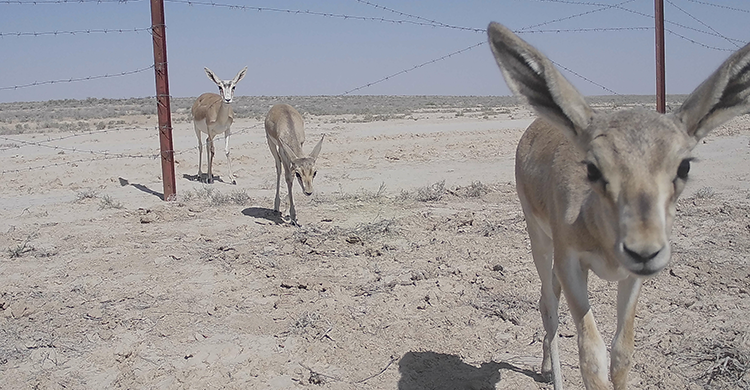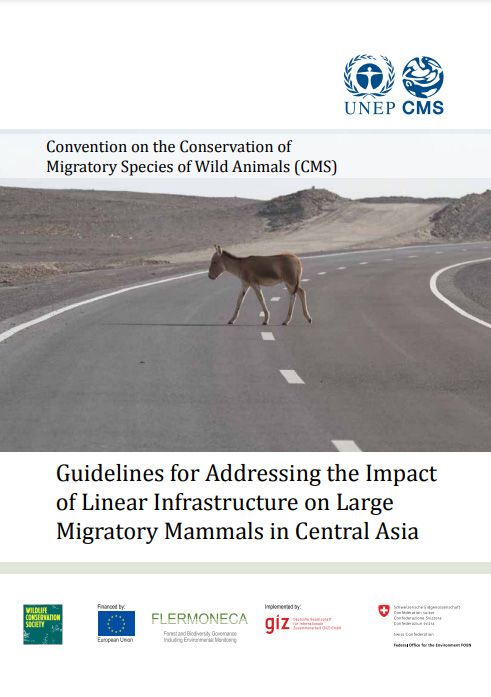Wildlife trafficking is estimated to be a multi-billion-dollar business involving the unlawful harvest and trade of animals and plants. Saiga Antelopes (Saiga spp.) are critically endangered according to the IUCN Red List assessment of 2018. As shown in the Overview Report, presented at the fourth Meeting of Signatories to the Saiga MOU in September 2021, almost all Saiga populations have grown in recent years.
Acinonyx jubatus

The Cheetah (Acinonyx jubatus) is the fastest land mammal and can move at a speed of up to 103 km per hour over a distance of hundreds of meters. Cheetahs mostly hunt during the day and their main prey comprises small- to mid-size ungulates, especially gazelles.
Main threats to the Cheetah include poaching and habitat degradation. The habitat degradation is caused by overgrazing and severe droughts resulting from natural and human-induced changes. Grazing and agricultural activities are permitted even inside most protected areas, placing additional pressure on Cheetahs and their prey through disturbance and harsher competition with livestock. Herders kill Cheetahs, as they believe they pose threat to domestic animals.
Conservation:
The Cheetah was listed on the CMS Appendix I in 2009 (except the populations of Botswana, Namibia and Zimbabwe).
The African Cheetah, with several subspecies occurring in different African countries, is listed as a vulnerable (VU) species on the IUCN Red List. The Cheetah in Africa, together with the African Wild Dog (Lycaon pictus), Lion (Panthera leo), and Leopard (Panthera pardus) is covered by in the Joint CITES-CMS African Carnivores Initiative (ACI).
The Asiatic Cheetah (Acinonyx jubatus venaticus), the subspecies of Cheetah that is found in Iran, is listed as critically endangered (CE) by the IUCN. The Asiatic Cheetah was included in Central Asian Mammals Initiative (CAMI) in 2014.
Le guépard (Acinonyx jubatus) est le mammifère terrestre le plus rapide et peut se déplacer à une vitesse allant jusqu'à 103 km à l'heure sur une distance de plusieurs centaines de mètres. Les guépards chassent généralement pendant la journée et leurs principales proies sont des ongulés de petite et moyenne taille, en particulier des gazelles.
Les principales menaces qui pèsent sur le guépard sont le braconnage et la dégradation de l'habitat. La dégradation de l'habitat est causée par le surpâturage et de graves sécheresses résultant de changements naturels et anthropiques. Le pâturage et les activités agricoles sont autorisés même à l'intérieur de la plupart des zones protégées, ce qui exerce une pression supplémentaire sur les guépards et leurs proies en raison des perturbations et de la concurrence plus rude avec le bétail. Les éleveurs tuent les guépards, car ils estiment qu'ils représentent une menace pour les animaux domestiques.
Conservation :
Le guépard a été inscrit à l'Annexe I de la CMS en 2009 (sauf les populations du Botswana, de la Namibie et du Zimbabwe).
Le guépard africain, dont plusieurs sous-espèces sont présentes dans différents pays africains, est inscrit comme espèce vulnérable (VU) sur la liste rouge de l'UICN. Le guépard d'Afrique, ainsi que le lycaon (Lycaon pictus), le lion (Panthera leo) et le léopard (Panthera pardus) sont couverts par l'Initiative conjointe CITES-CMS sur les carnivores africains (ACI).
Le guépard d'Asie (Acinonyx jubatus venaticus), la sous-espèce de guépard que l'on trouve en Iran, est classée en danger critique d'extinction (CE) par l'UICN. Le guépard d'Asie a été inclus dans l'Initiative pour les mammifères d'Asie centrale (CAMI) en 2014.
| CMS Instruments | CMS, Central Asian Mammals Initiative, African Carnivores Initiative |
|---|---|
| IUCN Status | Vulnerable |
| Date of entry in Appendix I | 2009 |
| Countries | Algeria, Angola, Benin, Burkina Faso, Cameroon, Central African Republic, Chad, Democratic Republic of the Congo (Kinshasa), Egypt, Ethiopia, Gambia, Iran, Kenya, Libya, Malawi, Mali, Mauritania, Mozambique, Niger, Pakistan, Senegal, Somalia, South Africa, South Sudan, Sudan, Tunisia, Uganda, United Republic of Tanzania, Zambia |
|---|
| English | Cheetah |
|---|---|
| French | Guépard |
| Spanish | Chita |
| German | Gepard |
| Class | Mammalia |
|---|---|
| Order | Carnivora |
| Family | Felidae |
| Scientific name | Acinonyx jubatus |
| Author | Schreber 1775 |
| Standard reference | Wilson, D.E. & Reeder, D.M. Eds., 2005. Mammal Species of the World. A Taxonomic and Geographic Reference. Third Edition. John Hopkins University Press |
Current Focus
E-Newsletter: CAMI Newsletter April 2024
Publication: Guidelines for Addressing the Impact of Linear Infrastructure on Large Migratory Mammals in Central Asia
| Additional notes | Except the populations of Botswana, Namibia and Zimbabwe. Sauf les populations du Botswana, de la Namibie et du Zimbabwe. |
|---|






